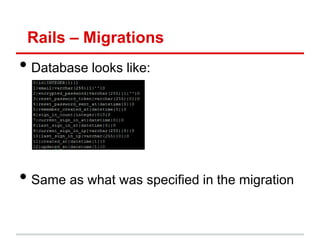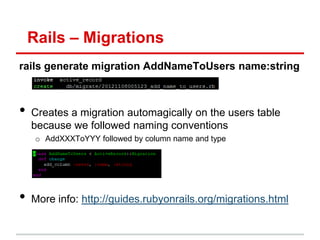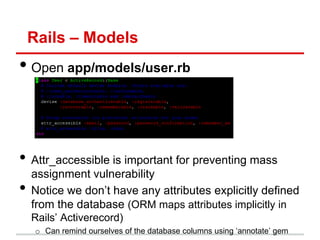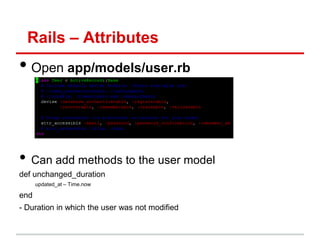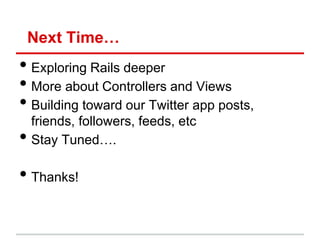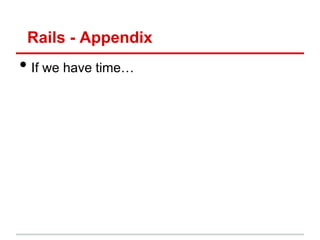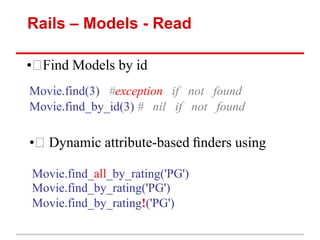Code for Startup MVP (Ruby on Rails) Session 2
- 1. Learning to Code for Startup MVP Presented by Henry Shi
- 2. Agenda – Wednesday November 7 1. Review of Last Session 2. Ruby Basics o Syntax and semantics o Practice makes perfect 1. Rails Models (but no Bottles) o ORM and SQL introduction o Migrations o Making the User model o Signup/Signin/Signout
- 3. Prework – Setup • Windows (not recommended if possible): o http://railsinstaller.org/ o Use Sublime Text for your text editor • OSX: o http://railsinstaller.org/ o This includes osx-gcc-installer (200mb) • Linux: o http://blog.sudobits.com/2012/05/02/how-to-install- ruby-on-rails-in-ubuntu-12-04-lts/
- 4. Prework - Git Install git if not already included: http://www.git-scm.com/book/en/Getting- Started-Installing-Git Configure Git: git config --global user.name "Your Name“ git config --global user.email [email protected]
- 5. Review of Last Session 1. The Web and How it Works 2. Git/Github 3. Rails and Ruby 4. Heroku
- 6. The Web - Overview
- 7. GIT/GITHUB • What is GIT? • Distributed Version Control System (DVCS) • Why should I care? o Never lose data or accidentally overwrite, delete files o Collaborate with peers anywhere and stay in sync automatically (no more _v1, _v2, _final, _final_final…) o Compare and track changes over time, and easily revert changes o Deploy code to real web
- 8. Rails • Ruby on Rails is an open-source web framework that‟s optimized for programmer happiness and sustainable productivity. • It lets you write beautiful code by favoring convention over configuration. • 80/20 Rule =>great for Startup MVP
- 9. Heroku What is Heroku? •a hosted platform built specifically for deploying Rails and other web applications in 1 command •Best thing since sliced bread
- 10. Ruby – Programmer’s Best Friend • Ruby is a dynamic, open source programming language with a focus on simplicity and productivity. It has an elegant syntax that is natural to read and easy to write. • We will only cover the necessary syntax needed to create a rails app • Thankfully, its not a lot
- 11. Interactive Ruby Shell • For the following slides, you should follow along with the Interactive Ruby Shell (irb) • Open a terminal, type irb and press enter
- 12. Ruby - Strings • Characters (letters, digits, punctuation) surrounded by quotes food = "chunky bacon" puts "I'm hungry for, #{food}!" >> "I'm hungry for, chunky bacon!" • Can perform operations on strings, concatenation, length, empty, etc “Hello” + “World” >> “Hello World" “Henry”.empty? >> false
- 13. Ruby - Numbers • Self Explanatory 123.class (123.0).class >> Fixnum >> Float • Can add different types of numbers directly
- 14. Ruby - Symbols • Characters (letters, digits, punctuation) preceded by colon (:) food = :hello :asf3fasdf.class >> Symbol • Lightweight strings • immutable
- 15. Ruby - Array • List surrounded by square brace and separated by commas, zero indexed a = [1, 2, 3] b = ('a'..'e').to_a # ["a", "b", "c", "d", "e"] c = %w[foo bar baz quux] # ["foo", "bar", "baz", "quux"] d = "foo bar baz".split # ["foo", "bar", "baz"] a[0] # 3 • Can perform operations on arrays, add, remove, reverse etc a.push(“hello”) # [1, 2, 3, “hello”] a << “world” # [1, 2, 3, “hello”, “world”] a = a.reverse # [“world”, “hello”, 3, 2, 1] a.delete(“hello”) # [“world”, 3, 2, 1]
- 16. Ruby - Hash • Hash is a dictionary surrounded by curly braces • Dictionaries match words with their definitions my_var = {:sup => "dog", :foo => "bar"} my_var[:foo] >> "bar“ my_var[:nk] = “new” # {foo : "bar“, nk: “new” , sup : "dog" } • New (better) hash notation in Ruby 1.9+ {sup : "dog", foo : "bar"}.class #Ruby 1.9+ >> Hash • Important for passing optional params (can omit braces if hash is last argument)
- 17. Ruby – Methods (Functions) • Function that performs some operations when called and returns something when done • Implicitly returns last expression in method • Use Ruby poetry style: o a.should(be() >= 7) #bad o a.should be >= 7
- 18. Ruby – Blocks • Block of Code surrounded by curly braces 2.times { puts "hello"} 2.times do >> "hello" puts "hello“ >> "hello" end • Can use Do and end to indicate block as well • Can take arguments o variables surrounded by pipe (|) 2.times do |i| puts "hello {#i}” end >> "hello 0" >> "hello 1"
- 19. Ruby – Blocks (Advanced Only) • Blocks are closures: they carry their environment around with them • Block are anonymous λ functions • Examples compared to scheme: o (map '(lambda (x) (+ x 2)) mylist ) o mylist.map { |x| x+2 } (map '(lambda (x) (+ x 2)) (filter '(lambda (x) (even? x)) mylist)) mylist.select {|x| x.even?}.map {|x| x+2 } • Try this: ('a'..'z').to_a.shuffle[0..7].join
- 20. Ruby – Blocks, Methods, Hashes def list_hash(options = {:default => "foo"}) options.each do |key, value| puts "key '#{key}' points to '#{value}'" end end list_hash override : "bar") >> "key 'override' points to 'bar'" list_hash multiple : "values", can : "be_passed") >> "key 'multiple' points to 'values'" >> "key 'can' points to 'be_passed'"
- 21. Ruby – Hashes in Rails • Used heavily as parameters
- 22. Ruby – Classes and Objects • Ruby, like many object-oriented languages, uses classes to organize methods; these classes are then instantiated to create objects
- 23. Ruby – Classes and Objects • Most common uses will be in Models and Controllers • attribute accessors (attr_accessor) corresponding to a user‟s name and email address. • This creates “getter” and “setter” methods that allow us to retrieve (get) and assign (set) @name and @email instance variables
- 24. Ruby Class and Object Example • Save the above code into a file called example_user.rb • Run the following in irb
- 25. Ruby – Classes and Objects (Advanced Only) class SavingsAccount < Account # inheritance # constructor used when SavingsAccount.new(...) called def initialize(starting_balance=0) # optional argument @balance = starting_balance end def balance # instance method @balance # instance var: visible only to this object end def balance=(new_amount) # note method name: like setter @balance = new_amount end def deposit(amount) @balance += amount end @@bank_name = "MyBank.com" # class (static) variable # A class method def self.bank_name # note difference in method def @@bank_name end # or: def SavingsAccount.bank_name ; @@bank_name ; end end
- 26. Ruby – Objects and Method Calls (Advanced Only) • Even lowly integers and nil are true objects: 57.methods 57.heinz_varieties nil.respond_to?(:to_s) " • Rewrite each of these as calls to send:" – Example: my_str.length => my_str.send(:length) 1 + 2 1.send(:+, 2) my_array[4] my_array.send(:[], 4) my_array[3] = "foo" my_array.send(:[]=, 3,"foo") if (x == 3) .... if (x.send(:==, 3)) ... my_func(z) self.send(:my_func, z) • When you are calling a method, you are actually sending a method call to the receiver object, which responds
- 27. Ruby – Method Calls (Advanced Only) • Every operation is a method call y = [1,2] y = y + ["foo",:bar] # => [1,2,"foo",:bar] y << 5 # => [1,2,"foo",:bar,5] y << [6,7] # => [1,2,"foo",:bar,5,[6,7]] • Remember! These are nearly all instance methods of Array —not language operators!" • So 5+3, "a"+"b", and [a,b]+[b,c] are all different methods named '+'" – Numeric#+, String#+, and Array#+, to be specific" • a.b means: call method b on object a – is the receiver to which you send the method call, a assuming a will respond to that method"
- 28. Ruby – Practice • Tryruby.org (code in ruby on your browser and work through free exercises) • Read Section 4.1 to 4.5 of Ruby on Rails Tutorial by Michael Hartl
- 29. Rails - Models We will focus on Models in this section But First, we must understand the underlying datastore that actually stores the data Databases, Tables, SQL
- 30. Rails – Database backed Models • Store and access massive amounts of data • Table o Columns (name, type, modifier) o Rows Table:Users
- 31. SQL • Structured Query Language o A way to talk to databases • Operations (CRUD) o Create o Read (Query) o Update o Delete o Schema creation and modification SELECT * FROM Book WHERE price > 100.00 ORDER BY title;
- 32. Rails – Object Relational Mapping • Maps database backend to ruby objects • ActiveRecord (Rail‟s Default ORM) >> userVariable = User.where(name: "Bob") Generates: SELECT "users".* FROM "users" WHERE (name = 'bob') >> userVariable.name => Bob
- 33. Rails – Object Relational Mapping >> userVariable = User.where(name: "Bob") models/user.rb class User < ActiveRecord::Base attr_accesor :name, :email end • Plural of Model name is table name (User -> users) • Subclassing from ActiveRecord::Base “Connects” a model to the database o Provides CRUD operations on the model o Database table column names are getters & setters for model attributes o Model attributes automagically defined from the database table columns
- 34. Rails – Creating Users • We could start from scratch and create all aspects of the Users models from scratch, but that wouldn‟t be in the philosophy of an MVP • What additional functions might a user model need? o Registration o Log in/Log out (sessions) o Reset/Lost Password o Email confirmations o Invitations to friends
- 35. Rails – Creating Users - Devise • We will use the awesome Gem: Devise • Gems are packages/libraries for your rails project • Before coding, always see if a gem exists at The Rails Toolbox
- 36. Rails - Devise • Create a new rails app o rails new MiniTwitter • Open Gemfile (from last class) • Add the line: Gem ‘devise’, ‘2.1.0’ • Run Bundle install from the console • Install Devise by typing in the console: rails generate devise:install • Generate the user by typing in the console: rails generate devise User • Run the migration by typing in the console: Bundle exec rake db:migrate
- 37. Rails – Devise • You may seem some hints/warnings:
- 38. Rails – Devise • Go to http://localhost:3000/users/sign_up to see Devise in action! • Sign up a fake user account and now try to log in at http://localhost:3000/users/sign_in • Rails never shows or stores passwords in plaintext
- 39. Rails – Devise • What did we just do? o rails generate devise User o Focus on Migration and User Model
- 40. Rails – Migrations • Create data structure in your database • Set a database‟s schema incrementally o Consistent across multiple machines (no conflicts) o Easy to upgrade, rollback, track changes, etc • Migration is automatically created every time you create a model • Open db/migrate/[timestamp]_devise_create_users.rb
- 41. Rails – Migrations • Creates a table named Users • Adds Columns: o Email o Encrypted_password o Etc, etc o T.timestamps creates the columns created_at and updated_at autmagically o Can pass parameters to columns, default values, nullable, etc • Adds Indices: o Ensures uniqueness o Faster searching o Index on email
- 42. Rails – Migrations • Active Record Maps ruby objects to database • User.email
- 43. Rails – Migrations • Database looks like: • Same as what was specified in the migration
- 44. Rails – Migrations • Run a migration >> bundle exec rake db:migrate • Rollback (undo) a migration >> bundle exec rake db:rollback
- 45. Rails – Migrations rails generate migration AddNameToUsers name:string • Creates a migration automagically on the users table because we followed naming conventions o AddXXXToYYY followed by column name and type • More info: http://guides.rubyonrails.org/migrations.html
- 46. Rails – Models • Open app/models/user.rb • Attr_accessible is important for preventing mass assignment vulnerability • Notice we don‟t have any attributes explicitly defined from the database (ORM maps attributes implicitly in Rails‟ Activerecord) o Can remind ourselves of the database columns using „annotate‟ gem
- 47. Rails – Attributes • Open app/models/user.rb • Can add methods to the user model def unchanged_duration updated_at – Time.now end - Duration in which the user was not modified
- 48. Rails – Models- Validations • Check your parameters before save • Provided by ActiveModel class Person < ActiveRecord::Base validates :title, :presence => true end bob = Person.create(title: nil) >> bob.valid? => false >> bob.save => false
- 49. Rails – Models- Validations • Rails‟ built in validation :acceptance => Boolean. :confirmation => Boolean. :exclusion => { :in => Enumerable }. :inclusion => { :in => Enumerable }. :format => { :with => Regexp, :on => :create }. :length => { :maximum => Fixnum }. :numericality => Boolean. :presence => Boolean. :uniqueness => Boolean. • Can also write your own validations class User < ActiveRecord::Base validate :my_custom_validation private def my_custom_validation self.errors.add(:coolness, "bad") unless self.cool == “supercool” end end
- 50. Rails – Models and Migrations Exercises • Create a migration to add first_name and last_name to the User table • Add validation for user‟s email, first_name and last_name such that they must be present • Make a method full_name on user object to retrieve user‟s full name by concatenating first and last name
- 51. Rails - Models • Further Reading Ruby on Rails Tutorial – Michael Hartl Section 6.1 – 6.2 (6.3 optional)
- 52. Git Commit git init git add . git commit –m “Initial Commit of MiniTwitter” (optional) git remote add origin [email protected]:<username>/first_app.git (optional)git push –u origin master
- 53. Heroku – New MiniTwitter App • Sign up for Heroku (it‟s Free!) http://api.heroku.com/signup • Install the Heroku Toolbelt https://toolbelt.heroku.com/ • Heroku login • Heroku create o This will create a heroku app and tell you the url of your app • Git push heroku master o This‟ll deploy your code to Heroku. Let it do its magic! • Heroku run rake db:migrate • Heroku open
- 54. Next Time… • Exploring Rails deeper • More about Controllers and Views • Building toward our Twitter app posts, friends, followers, feeds, etc • Stay Tuned…. • Thanks!
- 55. Rails - Appendix • If we have time…
- 56. Rails – Models - Create • Must call save or save! on an AR model instance to actually save changes to DB" – version is ―dangerous‖: throws exception if '!' operation fails" – create just combines new and save • Once created, object acquires a primary key (id column in every AR model table)" – x.id is nil or x.new_record? is true, x if has never been saved" – These behaviors inherited from ActiveRecord:: Base—not true of Ruby objects in general"
- 57. Rails – Models - Read • Class method where selects objects based on attributes Movie.where("rating='PG’) Movie.where('release_date < :cutoff and rating = :rating', :rating => 'PG', :cutoff => 1.year.ago) Movie.where("rating=#{rating}") # BAD IDEA! • Can be chained together efficiently kiddie = Movie.where("rating='G') old_kids_films = kiddie.where "release_date < ?",
- 58. Rails – Models - Read • Find Models by id Movie.find(3) #exception if not found Movie.find_by_id(3) # nil if not found • Dynamic attribute-based finders using Movie.find_all_by_rating('PG') Movie.find_by_rating('PG') Movie.find_by_rating!('PG')
- 59. Rails – Models - Delete • Note! destroy is an instance method m = Movie.find_by_name('The Help') m.destroy • There s alsodelete, which doesn t trigger lifecycle callbacks we ll discuss later (so, avoid it)" • Once an AR object is destroyed, you can access but not modify in-memory object m.title = 'Help'
Editor's Notes
- #5: Remind of pg gem
- #6: Show Other Slides
- #8: Briefly mention attr_accessible and instance variables @
- #17: May need to uncomment #therubyracer gem
- #18: No need to worry for now
- #19: can sign out by issuing HTTP DELETE to http://localhost:3000/users/sign_out
- #20: Replace with better database chart
- #23: Talk about client-side validations: gem 'client_side_validations’














![Ruby - Array
• List surrounded by square brace and
separated by commas, zero indexed
a = [1, 2, 3]
b = ('a'..'e').to_a # ["a", "b", "c", "d", "e"]
c = %w[foo bar baz quux] # ["foo", "bar", "baz", "quux"]
d = "foo bar baz".split # ["foo", "bar", "baz"]
a[0] # 3
• Can perform operations on arrays, add,
remove, reverse etc
a.push(“hello”) # [1, 2, 3, “hello”]
a << “world” # [1, 2, 3, “hello”, “world”]
a = a.reverse # [“world”, “hello”, 3, 2, 1]
a.delete(“hello”) # [“world”, 3, 2, 1]](https://image.slidesharecdn.com/learningtocodeforstartupmvpsession2-121107202754-phpapp01/85/Code-for-Startup-MVP-Ruby-on-Rails-Session-2-15-320.jpg)
![Ruby - Hash
• Hash is a dictionary surrounded by curly braces
• Dictionaries match words with their definitions
my_var = {:sup => "dog", :foo => "bar"}
my_var[:foo]
>> "bar“
my_var[:nk] = “new” # {foo : "bar“, nk: “new” , sup : "dog" }
• New (better) hash notation in Ruby 1.9+
{sup : "dog", foo : "bar"}.class #Ruby 1.9+
>> Hash
• Important for passing optional params (can omit braces if
hash is last argument)](https://image.slidesharecdn.com/learningtocodeforstartupmvpsession2-121107202754-phpapp01/85/Code-for-Startup-MVP-Ruby-on-Rails-Session-2-16-320.jpg)


![Ruby – Blocks (Advanced Only)
• Blocks are closures: they carry their
environment around with them
• Block are anonymous λ functions
• Examples compared to scheme:
o (map '(lambda (x) (+ x 2)) mylist )
o mylist.map { |x| x+2 }
(map
'(lambda (x) (+ x 2))
(filter '(lambda (x) (even? x)) mylist))
mylist.select {|x| x.even?}.map {|x| x+2 }
• Try this: ('a'..'z').to_a.shuffle[0..7].join](https://image.slidesharecdn.com/learningtocodeforstartupmvpsession2-121107202754-phpapp01/85/Code-for-Startup-MVP-Ruby-on-Rails-Session-2-19-320.jpg)



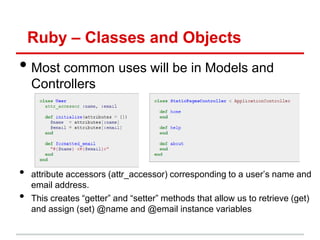

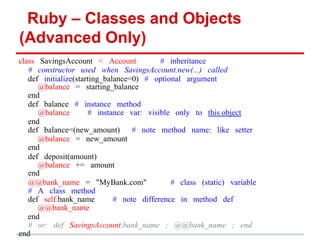
![Ruby – Objects and Method Calls
(Advanced Only)
• Even lowly integers and nil are true objects:
57.methods
57.heinz_varieties
nil.respond_to?(:to_s) "
• Rewrite each of these as calls to send:"
– Example: my_str.length => my_str.send(:length)
1 + 2 1.send(:+, 2)
my_array[4] my_array.send(:[], 4)
my_array[3] = "foo" my_array.send(:[]=, 3,"foo")
if (x == 3) .... if (x.send(:==, 3)) ...
my_func(z)
self.send(:my_func, z)
• When you are calling a method, you are actually sending
a method call to the receiver object, which responds](https://image.slidesharecdn.com/learningtocodeforstartupmvpsession2-121107202754-phpapp01/85/Code-for-Startup-MVP-Ruby-on-Rails-Session-2-26-320.jpg)
![Ruby – Method Calls (Advanced
Only)
• Every operation is a method call
y = [1,2]
y = y + ["foo",:bar] # => [1,2,"foo",:bar]
y << 5 # => [1,2,"foo",:bar,5]
y << [6,7] # => [1,2,"foo",:bar,5,[6,7]]
• Remember! These are nearly all instance methods of Array
—not language operators!"
• So 5+3, "a"+"b", and [a,b]+[b,c] are all different
methods named '+'"
– Numeric#+, String#+, and Array#+, to be specific"
• a.b means: call method b on object a
– is the receiver to which you send the method call,
a
assuming a will respond to that method"](https://image.slidesharecdn.com/learningtocodeforstartupmvpsession2-121107202754-phpapp01/85/Code-for-Startup-MVP-Ruby-on-Rails-Session-2-27-320.jpg)





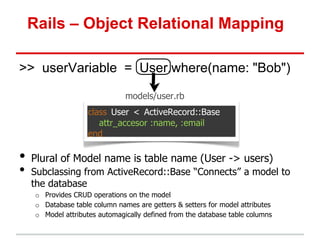
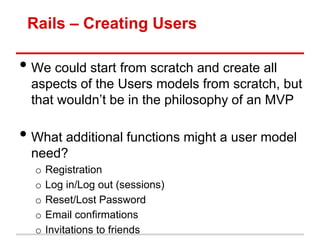


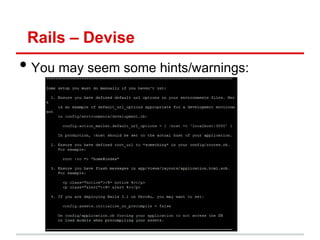


![Rails – Migrations
• Create data structure in your database
• Set a database‟s schema incrementally
o Consistent across multiple machines (no conflicts)
o Easy to upgrade, rollback, track changes, etc
• Migration is automatically created every time
you create a model
• Open db/migrate/[timestamp]_devise_create_users.rb](https://image.slidesharecdn.com/learningtocodeforstartupmvpsession2-121107202754-phpapp01/85/Code-for-Startup-MVP-Ruby-on-Rails-Session-2-40-320.jpg)


